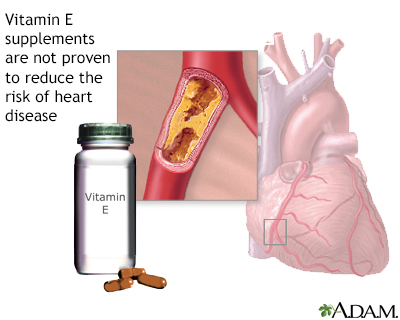Pregnancy SmartSiteTM
Alpha-tocopherol; Gamma-tocopherol DefinitionVitamin E is a fat-soluble vitamin. Your body stores vitamin E in fatty tissue and the liver. FunctionVitamin E has the following functions:
Determining whether vitamin E can prevent cancer, heart disease, dementia, liver disease, and stroke requires further research. Food SourcesThe best way to get the daily requirement of vitamin E is by eating food sources. Vitamin E is found in the following foods:
Fortified means that vitamins have been added to the food. Check the Nutrition Fact Panel on the food label. Products made from these foods, such as margarine, also contain vitamin E. Side EffectsEating vitamin E in foods is not risky or harmful. However, high doses of vitamin E supplements (alpha-tocopherol supplements) might increase the risk of bleeding in the brain (hemorrhagic stroke). High levels of vitamin E may also increase the risk for birth defects. However, this needs more research. Low intake may lead to hemolytic anemia in premature babies. RecommendationsRecommendations for vitamin E, as well as other nutrients, are provided in the Dietary Reference Intakes (DRIs) developed by the Food and Nutrition Board at the National Academies of Sciences, Engineering, and Medicine. DRI is a term for a set of reference intakes that are used to plan and assess the nutrient intakes of healthy people. These values, which vary by age and sex, include: Recommended Dietary Allowance (RDA): The average daily level of intake that is enough to meet the nutrient needs of nearly all (97% to 98%) healthy people. An RDA is an intake level based on scientific research evidence. Adequate Intake (AI): This level is established when there is not enough scientific research evidence to develop an RDA. It is set at a level that is thought to ensure enough nutrition. Dietary reference intakes for vitamin E: Infants (AI)
Children (RDA)
Adolescents and adults (RDA)
Ask your health care provider which amount is best for you. The highest safe level of vitamin E supplements for adults is 1000 mg/day (equal to 1,500 IU/day for natural forms of vitamin E, and 1,100 IU/day for the man-made or synthetic form). ReferencesMarkell M, Siddiqi HA. Vitamins and trace elements. In: McPherson RA, Pincus MR, eds. Henry's Clinical Diagnosis and Management by Laboratory Methods. 24th ed. Philadelphia, PA: Elsevier; 2022:chap 27. Mason JB, Booth SL. Vitamins, trace minerals, and other micronutrients. In: Goldman L, Schafer AI, eds. Goldman-Cecil Medicine. 26th ed. Philadelphia, PA: Elsevier; 2020:chap 205. National Institutes of Health website. Vitamin E: fact sheet for health professionals. ods.od.nih.gov/factsheets/VitaminE-HealthProfessional/. Updated March 26, 2021. Accessed February 8, 2023. | |
| |
Review Date: 1/19/2023 Reviewed By: Stefania Manetti, RD/N, CDCES, RYT200, My Vita Sana LLC - Nourish and heal through food, San Jose, CA. Review provided by VeriMed Healthcare Network. Also reviewed by David C. Dugdale, MD, Medical Director, Brenda Conaway, Editorial Director, and the A.D.A.M. Editorial team. The information provided herein should not be used during any medical emergency or for the diagnosis or treatment of any medical condition. A licensed medical professional should be consulted for diagnosis and treatment of any and all medical conditions. Links to other sites are provided for information only -- they do not constitute endorsements of those other sites. No warranty of any kind, either expressed or implied, is made as to the accuracy, reliability, timeliness, or correctness of any translations made by a third-party service of the information provided herein into any other language. © 1997- A.D.A.M., a business unit of Ebix, Inc. Any duplication or distribution of the information contained herein is strictly prohibited. | |

 Vitamin E benefit
Vitamin E benefit Vitamin E source
Vitamin E source Vitamin E and hear...
Vitamin E and hear...
